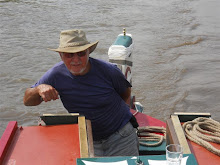18th May 2011
Berko to Hunton Bridge
It was mostly an uneventful day
of singling out between locks and breasting up for the locks. I should maybe
explain that towing allows the pair to travel a little faster than being
breasted up. If the boats were loaded, as they would be on a coal run, then
they would travel either on a snatcher (up to about 40ft) for the short pounds between locks or a snubber
(about 70 to 100ft) for much longer pounds. The loaded boats are lower in the
water which would impede the action of the motor propeller against the bow of
the butty if on cross straps, but a longer tow line allows the butty steerer to
keep out of the wash from the motor boat, by steering slightly to one side. At
every double lock the towline is removed from the motor boat dollies by the
motor steerer, which allows the butty to catch up the motor as they are
entering the lock. While this is happening, the motor steerer is coiling in the
tow line, which is then thrown or placed on the butty bow, allowing the butty
free rein to steer into the lock alongside the motor boat, where both boats are
tied together. Using the snatcher means there is less line to coil in at each
lock.
Towing on a snatcher.
Towing on a snubber.
We eventually moored between
Lock 72 and Bridge 162 at Hunton Bridge. Using a map of the waterways boats are
located according to either bridge numbers of lock numbers, although there are
some canals where the locks and bridges are named instead of numbers.
Janet left the boats here with
her kit to cycle down the towpath to Watford and the train home. Having not
been to Hunton Bridge before, no one knew where we could eat or drink, so we
popped into the corner shop and got a good recommendation for The Kings Lodge Hotel with Hunters Bar and Restaurant. Dating from 1662 with an interesting historic ceiling and fireplace in the bar, I believe it was Henry VIII's lodge when he was hunting in this area. At the present time, all beers and shorts were on offer
at £2.50 plus an excellent choice on the menu. Two servings of breast of duck
and one sea bass later washed down with well deserved beer – superb after a
hard day at the tiller!
Another pub has re-opened there since writing this – The Kings Head, which serves a good choice of ales, but the food is not quite up to the same standard. It is also an historic pub with a minstrels’ gallery and other historical artefacts of interest.
Another pub has re-opened there since writing this – The Kings Head, which serves a good choice of ales, but the food is not quite up to the same standard. It is also an historic pub with a minstrels’ gallery and other historical artefacts of interest.













